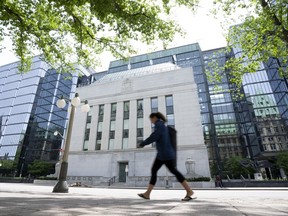Ted Rechtshaffen: Get ready to see actions speak louder than words over the coming year
Article content
They say that actions speak louder than words, and this definitely applies when it comes to the Bank of Canada.
Advertisement 2
Article content
The central bank now forecasts the consumer price inflation (CPI) index will return to two per cent in mid-2025. If this two-year prediction causes you concern that policymakers won’t be lowering rates for two years, fear not. It is quite amazing that they feel confident in making a prediction for two years out. Keep in mind that only 18 months ago, the overnight rate was still 0.25 per cent.
Article content
Two years is forever in terms of economic predictions, and, as a result, we should assume virtually nothing based on the prediction of a two-per-cent CPI by mid-2025.
To show what I mean, let’s take a closer look at the last time interest rates were this high, which was in 2001.
As 2000 turned to 2001, the Bank of Canada’s rate was at six per cent. It is 5.25 per cent today. Back then, real gross domestic product (GDP) was growing by 4.7 per cent and employment was rising by 2.6 per cent. Higher energy prices were boosting exports. There was growth in employment and wages and, together with tax cuts, this grew consumer spending.
Article content
Advertisement 3
Article content
To help deal with an overheating economy, the Bank of Canada began raising rates, starting in 1999, and peaking with a 50-basis-point hike in May 2000 to get to six per cent.
However, all was not rosy. The tech bubble burst in early 2000, and the end-of-year forecasts for 2001 were not great. GDP growth was expected to slip to between two and three per cent, according to private-sector forecasts. Among the concerns were the effects of previous increases in interest rates, higher energy prices and overall weakening confidence.
As it turned out, Canada’s GDP dropped all the way to 1.79 per cent in 2001 from 5.18 per cent in 2000. Unemployment was at 6.83 per cent in 2000 (much higher than today’s rates), but went up to 7.22 per cent in 2001 and 7.66 per cent in 2002.
Advertisement 4
Article content
The Bank of Canada kept its rate at six per cent throughout the second half of 2000, but as things weakened in the economy, it felt it was time to cut. Policymakers cut the rate by 25 bps in January 2001, and by the time they were done cutting one year later, the rate was 2.25 per cent, a full 375-basis-point cut in one year.
Did the Bank of Canada predict these moves in May 2000? No, it did not. At the time, it was clearly worried about higher inflation.

The May 2000 Bank of Canada Monetary Policy Report said: “ … (we see) several key areas of uncertainty for the conduct of Canadian monetary policy in the period ahead. First, the momentum of demand in Canada from both international and domestic sources could continue to outpace expectations. Second, a possible buildup of inflationary pressures in the United States could have implications for Canada. Third, the capacity of the Canadian economy to produce goods and services without adding to inflationary pressures may be higher than previously thought.”
Advertisement 5
Article content
This is not a knock on the Bank of Canada’s view from May 2000, although it might be instructive as to why you might not want to make a two-year prediction on when CPI will be back to two per cent.
There was a clear slowdown ahead in the economy, but things got much worse when the completely unpredictable 9/11 attacks in the United States took place. That helped push a meaningful slowdown in 2001 to a much worse place.
Clearly, there are many differences between 2001 and today. What led to the run-up in interest rates in 1999 and 2000 was different from the reasons for the run-up today. But some of the economic similarities are meaningful.
The monthly all-in CPI was just 0.66 per cent in January 1999. As the economy improved, the CPI rose to 2.63 per cent by December 1999, and was at 3.2 per cent in December 2000. By this time, the Bank of Canada had raised its rate to six per cent in an effort to calm inflation.
Advertisement 6
Article content
Whatever forced the economy to slow down, the impact was dramatic. The CPI was down to 0.62 per cent by November 2001. Now the central bank was in catch-up mode to try to spur the economy, so it quickly lowered the rate, eventually stopping declines in January 2002, when it was down to 2.25 per cent.
Is this instructive for what the Bank of Canada will do next with interest rates? I think so. The key takeaway for me is that things can quickly change.
Eighteen months ago, we had super low interest rates in Canada. Today, not so much. In late 2000, the rate was six per cent. By January 2002, it was 2.25 per cent.
Over the past 30 years, the Bank of Canada has raised rates ranging from 1.25 to 3.2 percentage points on six different occasions (prior to the significant current rate hikes). The one thing they all had in common was that it didn’t take long for each of them to be followed by a period of declining interest rates, ranging from 1.25 to 5.125 percentage points.
Advertisement 7
Article content
-

The case for ending Bank of Canada’s interest rate hikes now
-

Planning a long, healthy life? Here’s how to make your money last
-

6 ways to make more income from your investments
As the band Blood, Sweat and Tears famously sang back in 1968, “What goes up, must come down.” Get ready to see actions speak louder than words over the coming year on interest rates.
Ted Rechtshaffen, MBA, CFP, CIM, is president, portfolio manager and financial planner at TriDelta Financial, a boutique wealth management firm focusing on investment counselling and high-net-worth financial planning. You can contact him directly at tedr@tridelta.ca.
Article content
Big Bank of Canada interest rate cuts ahead if 2001 any indication
2023-07-25 10:00:46






Comments
Postmedia is committed to maintaining a lively but civil forum for discussion and encourage all readers to share their views on our articles. Comments may take up to an hour for moderation before appearing on the site. We ask you to keep your comments relevant and respectful. We have enabled email notifications—you will now receive an email if you receive a reply to your comment, there is an update to a comment thread you follow or if a user you follow comments. Visit our Community Guidelines for more information and details on how to adjust your email settings.
Join the Conversation